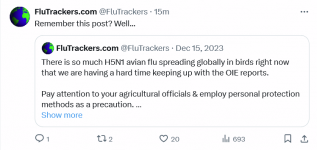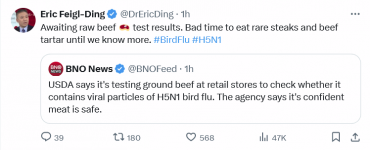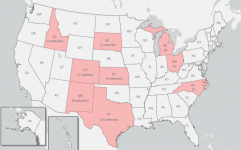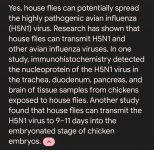You are using an out of date browser. It may not display this or other websites correctly.
You should upgrade or use an alternative browser.
You should upgrade or use an alternative browser.
HEALTH Bird flu that infected Texas man has mutated to spread more easily, CDC reveals —
- Thread starter jward
- Start date
jward
passin' thru
Ag commissioner says chickens destroyed to prevent bird flu spread being replaced
Erin Davis
3–4 minutes
TEXAS — Cows in the Texas panhandle tested positive for bird flu last month after thousands of livestock were killed in historic wildfires.
What You Need To Know
Bird flu struck about 40% of dairy cows in the Panhandle, where 82% of the state’s milk is produced
Experts say farmers should take certain biosecurity measures to protect their livestock from future cases
More than 1 million chickens were killed to prevent bird flu from spreading. Texas Agriculture Commissioner Sid Miller says they are easy to replace
One human contracted bird flu and experienced symptoms similar to pink eye. Experts say others aren’t at risk of being infected
The disease struck about 40% of dairy cows in the Panhandle, where 82% of the state’s milk is produced. Infected cows have stopped producing milk.
“The trick is, how do we return them back to their previous state of milk production?” said Darren Turley with the Association of Dairymen.
He says infected cows receive probiotics and electrolytes, but once a cow is no longer infected, it doesn’t always immediately resume milk production.
“If we have a cow that's not pregnant, and not giving any milk, it's very, very hard for us to make that work to keep that animal to pay for that animal,” Turley said.
Experts say farmers should take certain biosecurity measures to protect their livestock from future cases.
“Clean and disinfect those trucks coming on to your place. And the workers, too. If you have coveralls on at one dairy and that you’re not taking to other dairies, that would be of significant concern. And then if you’re a worker and dealing with sick cattle that they’re using personal protective equipment to ensure their safety as well,” said Dr. Brian Bohl, TAHC director of field operations.
Also in West Texas, more 1 million chickens were killed to prevent bird flu from spreading. Texas Agriculture Commissioner Sid Miller says they are easy to replace.
“We can have a new chicken hatched in 28 days. It doesn’t take that long. And that hen will be producing in less than six months from now. So once we get the birds disposed of, the house cleaned up, it'll be ready to restock and be back in business, you know, three to five months,” said Miller.
Miller says dairy and egg prices aren’t expected to increase and that the quality of the products is the same.
“We pasteurized most of the milk,” he said. “The only way you could get it is if [you're] drinking raw milk or unpasteurized dairy products. So if you want to be on the safe side, you might hold off on that for a while.”
One human contracted bird flu and experienced symptoms similar to pink eye. Experts say others aren’t at risk of being infected.
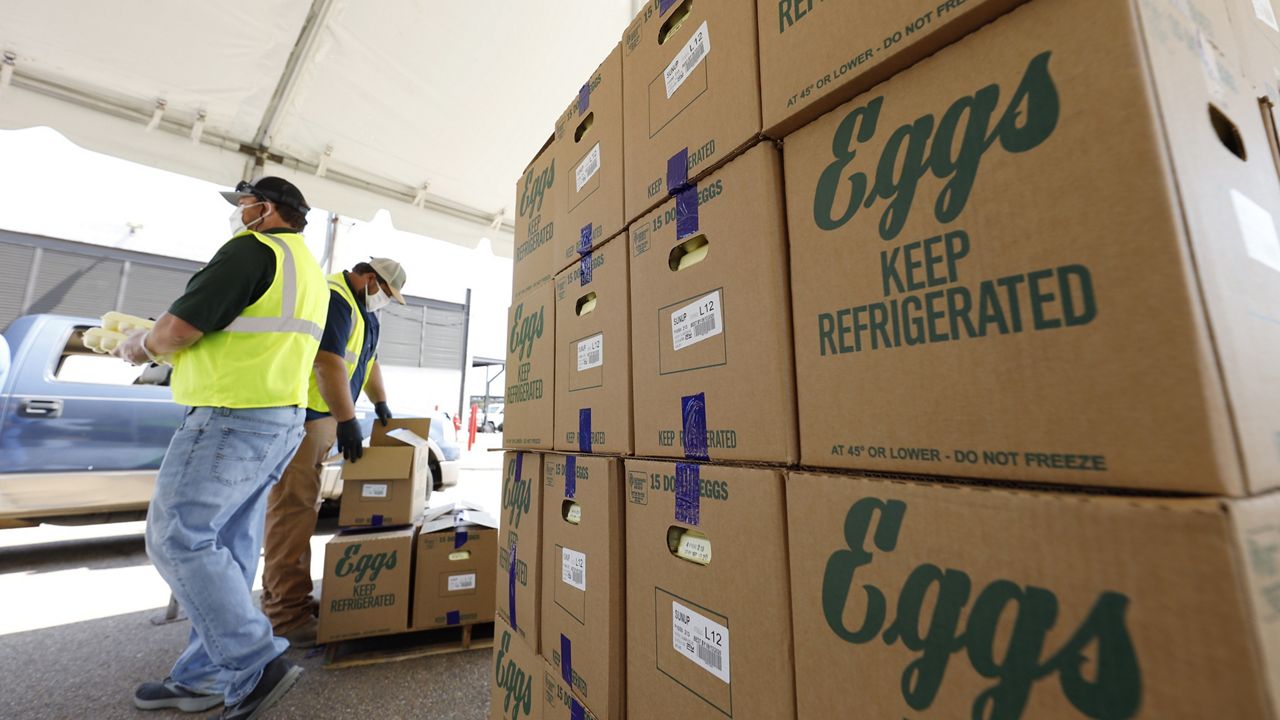
 spectrumlocalnews.com
spectrumlocalnews.com
Erin Davis
3–4 minutes
TEXAS — Cows in the Texas panhandle tested positive for bird flu last month after thousands of livestock were killed in historic wildfires.
What You Need To Know
Bird flu struck about 40% of dairy cows in the Panhandle, where 82% of the state’s milk is produced
Experts say farmers should take certain biosecurity measures to protect their livestock from future cases
More than 1 million chickens were killed to prevent bird flu from spreading. Texas Agriculture Commissioner Sid Miller says they are easy to replace
One human contracted bird flu and experienced symptoms similar to pink eye. Experts say others aren’t at risk of being infected
The disease struck about 40% of dairy cows in the Panhandle, where 82% of the state’s milk is produced. Infected cows have stopped producing milk.
“The trick is, how do we return them back to their previous state of milk production?” said Darren Turley with the Association of Dairymen.
He says infected cows receive probiotics and electrolytes, but once a cow is no longer infected, it doesn’t always immediately resume milk production.
“If we have a cow that's not pregnant, and not giving any milk, it's very, very hard for us to make that work to keep that animal to pay for that animal,” Turley said.
Experts say farmers should take certain biosecurity measures to protect their livestock from future cases.
“Clean and disinfect those trucks coming on to your place. And the workers, too. If you have coveralls on at one dairy and that you’re not taking to other dairies, that would be of significant concern. And then if you’re a worker and dealing with sick cattle that they’re using personal protective equipment to ensure their safety as well,” said Dr. Brian Bohl, TAHC director of field operations.
Also in West Texas, more 1 million chickens were killed to prevent bird flu from spreading. Texas Agriculture Commissioner Sid Miller says they are easy to replace.
“We can have a new chicken hatched in 28 days. It doesn’t take that long. And that hen will be producing in less than six months from now. So once we get the birds disposed of, the house cleaned up, it'll be ready to restock and be back in business, you know, three to five months,” said Miller.
Miller says dairy and egg prices aren’t expected to increase and that the quality of the products is the same.
“We pasteurized most of the milk,” he said. “The only way you could get it is if [you're] drinking raw milk or unpasteurized dairy products. So if you want to be on the safe side, you might hold off on that for a while.”
One human contracted bird flu and experienced symptoms similar to pink eye. Experts say others aren’t at risk of being infected.

Ag commissioner says chickens destroyed to prevent bird flu being replaced
The disease struck about 40% of dairy cows in the Panhandle
Infectious Disease Tracker
@HmpxvT
BREAKING:
H5N1 has affected about 40% of dairy cows in the Texas Panhandle, where 82% of the state’s milk is produced, according to Spectrum News.
5:11 PM · Apr 11, 2024
142.5K
Views
jward
passin' thru
FluTrackers.com
@FluTrackers
US - Gov. statement: "Highly Pathogenic Avian Influenza Detected in Three New Michigan Dairy Herds" (probable commercial herds) total known affected herds = 4 US - Dairy cows test positive for H5N1 avian flu in Texas, Kansas, Idaho, Michigan, New Mexico, Ohio, North Carolina, South Dakota - March 24+ One Texas human case April 1 - FluTrackers News and Information
h/t Treyfish #H5N1
3:29 PM · Apr 12, 2024
523
Views
@FluTrackers
US - Gov. statement: "Highly Pathogenic Avian Influenza Detected in Three New Michigan Dairy Herds" (probable commercial herds) total known affected herds = 4 US - Dairy cows test positive for H5N1 avian flu in Texas, Kansas, Idaho, Michigan, New Mexico, Ohio, North Carolina, South Dakota - March 24+ One Texas human case April 1 - FluTrackers News and Information
h/t Treyfish #H5N1
3:29 PM · Apr 12, 2024
523
Views
jward
passin' thru
FluTrackers.com
@FluTrackers
US - WOAH - #H5N1 avian flu in a wild mink in Bourbon county, Kentucky Kentucky - Avian flu in mammals - 2024 - FluTrackers News and Information
h/t Pathfinder
1:39 PM · Apr 12, 2024
1,543
Views
@FluTrackers
US - WOAH - #H5N1 avian flu in a wild mink in Bourbon county, Kentucky Kentucky - Avian flu in mammals - 2024 - FluTrackers News and Information
h/t Pathfinder
1:39 PM · Apr 12, 2024
1,543
Views
psychgirl
Has No Life - Lives on TB
Good Lord
Here we go.
jward
passin' thru
FluTrackers.com
@FluTrackers
Canada - WOAH: "We report additional cases of highly pathogenic avian influenza (HPAI) #H5N1 virus in skunks." (4 skunks in 3 different provinces) Canada - Outbreaks of highly pathogenic avian influenza H5N1 in non-poultry including wild birds (WOAH, June 29, 2023 -) - FluTrackers News and Information
h/t Pathfinder
6:40 PM · Apr 15, 2024
609
Views
@FluTrackers
Canada - WOAH: "We report additional cases of highly pathogenic avian influenza (HPAI) #H5N1 virus in skunks." (4 skunks in 3 different provinces) Canada - Outbreaks of highly pathogenic avian influenza H5N1 in non-poultry including wild birds (WOAH, June 29, 2023 -) - FluTrackers News and Information
h/t Pathfinder
6:40 PM · Apr 15, 2024
609
Views
jward
passin' thru
phys.org
Science X
4–5 minutes
 Credit: Pixabay/CC0 Public Domain
Credit: Pixabay/CC0 Public Domain
The case of a Florida bottlenose dolphin found with highly pathogenic avian influenza virus, or HPAIV—a discovery made by University of Florida researchers in collaboration with multiple other agencies and one of the first reports of a constantly growing list of mammals affected by this virus—has been published in Communications Biology.
The report documents the discovery, the first finding of HPAIV in a cetacean in North America, from the initial response by UF's Marine Animal Rescue team to a report of a distressed dolphin in Dixie County, Florida, to the subsequent identification of the virus from brain and tissue samples obtained in a postmortem examination.
Analyses initially performed at UF's zoological medicine diagnostic laboratory ruled out the presence of other potential agents at play in the dolphin's disease, with the Bronson Animal Disease Diagnostic Laboratory in Kissimmee, Florida, verifying the presence of HPAI virus in both the lung and brain.
Those results were confirmed by the National Veterinary Services Laboratory in Ames, Iowa, which characterized the virus subtype and pathotype. The virus was confirmed to be HPAI A (H5N1) virus of HA clade 2.3.4.4b. Subsequent tissue analysis was performed at the Biosafety Level 3 enhanced laboratory at St. Jude Children's Research Hospital in Memphis.
Allison Murawski, D.V.M., a former intern with UF's aquatic animal medicine program, was first author on the study and developed a case report on the dolphin as part of her research project. She traveled to Memphis and worked closely with Richard Webby, Ph.D., who directs the World Health Organization Collaborating Center for Studies on the Ecology of Influenza in Animals and Birds at St. Jude's and served as corresponding author on the paper
Webby's laboratory investigates avian influenza cases in many species and was key in determining where the virus may have originated, what unique RNA characteristics or mutations were present that could suggest its ability to infect other mammals, and how the virus could be tracked from this source.
The researchers sequenced the genomes from local birds and looked at viruses isolated from Northeast seal populations.
"We still don't know where the dolphin got the virus and more research needs to be done," Webby said.
"This investigation was an important step in understanding this virus and is a great example where happenstance joins with curiosity, having to answer the 'why' and then seeing how the multiple groups and expertise took this to a fantastic representation of collaborative excellence," said Mike Walsh, D.V.M., an associate professor of aquatic animal health, who served as Murawski's faculty mentor.
More information: Allison Murawski et al, Highly pathogenic avian influenza A(H5N1) virus in a common bottlenose dolphin (Tursiops truncatus) in Florida, Communications Biology (2024). DOI: 10.1038/s42003-024-06173-x
Citation: Florida dolphin found with highly pathogenic avian flu: Report (2024, April 26) retrieved 26 April 2024 from Florida dolphin found with highly pathogenic avian flu: Report
This document is subject to copyright. Apart from any fair dealing for the purpose of private study or research, no part may be reproduced without the written permission. The content is provided for information purposes only.
Florida dolphin found with highly pathogenic avian flu: Report
Florida dolphin found with highly pathogenic avian flu: Report
Science X
4–5 minutes

The case of a Florida bottlenose dolphin found with highly pathogenic avian influenza virus, or HPAIV—a discovery made by University of Florida researchers in collaboration with multiple other agencies and one of the first reports of a constantly growing list of mammals affected by this virus—has been published in Communications Biology.
The report documents the discovery, the first finding of HPAIV in a cetacean in North America, from the initial response by UF's Marine Animal Rescue team to a report of a distressed dolphin in Dixie County, Florida, to the subsequent identification of the virus from brain and tissue samples obtained in a postmortem examination.
Analyses initially performed at UF's zoological medicine diagnostic laboratory ruled out the presence of other potential agents at play in the dolphin's disease, with the Bronson Animal Disease Diagnostic Laboratory in Kissimmee, Florida, verifying the presence of HPAI virus in both the lung and brain.
Those results were confirmed by the National Veterinary Services Laboratory in Ames, Iowa, which characterized the virus subtype and pathotype. The virus was confirmed to be HPAI A (H5N1) virus of HA clade 2.3.4.4b. Subsequent tissue analysis was performed at the Biosafety Level 3 enhanced laboratory at St. Jude Children's Research Hospital in Memphis.
Allison Murawski, D.V.M., a former intern with UF's aquatic animal medicine program, was first author on the study and developed a case report on the dolphin as part of her research project. She traveled to Memphis and worked closely with Richard Webby, Ph.D., who directs the World Health Organization Collaborating Center for Studies on the Ecology of Influenza in Animals and Birds at St. Jude's and served as corresponding author on the paper
Webby's laboratory investigates avian influenza cases in many species and was key in determining where the virus may have originated, what unique RNA characteristics or mutations were present that could suggest its ability to infect other mammals, and how the virus could be tracked from this source.
The researchers sequenced the genomes from local birds and looked at viruses isolated from Northeast seal populations.
"We still don't know where the dolphin got the virus and more research needs to be done," Webby said.
"This investigation was an important step in understanding this virus and is a great example where happenstance joins with curiosity, having to answer the 'why' and then seeing how the multiple groups and expertise took this to a fantastic representation of collaborative excellence," said Mike Walsh, D.V.M., an associate professor of aquatic animal health, who served as Murawski's faculty mentor.
More information: Allison Murawski et al, Highly pathogenic avian influenza A(H5N1) virus in a common bottlenose dolphin (Tursiops truncatus) in Florida, Communications Biology (2024). DOI: 10.1038/s42003-024-06173-x
Citation: Florida dolphin found with highly pathogenic avian flu: Report (2024, April 26) retrieved 26 April 2024 from Florida dolphin found with highly pathogenic avian flu: Report
This document is subject to copyright. Apart from any fair dealing for the purpose of private study or research, no part may be reproduced without the written permission. The content is provided for information purposes only.
Florida dolphin found with highly pathogenic avian flu: Report
jward
passin' thru
1 in 5 US retail milk samples test positive for H5N1 avian flu fragments
Lisa Schnirring April 25, 2024
A senior official from the US Food and Drug Administration (FDA) said today that its nationwide survey of retail milk has found remnants of H5N1 avian flu viruses in one in five samples, with the highest concentrations in regions where outbreaks in dairy cattle have been reported.
Donald Prater, DVM, acting director of the FDA Center for Food Safety and Applied Nutrition (CFSAN), shared the new findings with state health officials who took part in a scientific symposium on H5N1 hosted by the Association of State and Territorial Health Officials (ASTHO). The results come in the wake of earlier findings this week from more limited FDA sampling, along with similar findings from a smaller set of samples tested by a lab that's part of the National Institute of Allergy and Infectious Diseases Centers of Excellence for Influenza Research and Response (CEIRR) Network.
At today's ASTHO briefing, state health officials heard the latest investigation and research updates from federal health officials and had the opportunity to ask their own questions, everything from virus shedding in cow manure to pandemic preparedness.
FDA's long list of research questions
Prater reiterated that the FDA hasn't changed its assessment that the nation's milk supply remains safe. So far, early work on milk samples that were positive for H5N1 fragments haven't found any viable (potentially infectious) virus.He said, however, that the FDA still has a long list of data gaps to fill, including identifying the risk of infection to humans via oral consumption and validating that existing pasteurization methods can inactivate H5N1.
Other data gaps include how long the virus survives in raw milk and the infectious dose of viruses. Though a major concern is retail milk, Prater also said the FDA needs to see if contamination is occurring in other products, such as cheese made from raw milk.
USDA continues to probe farm transmission patterns
Rosemary Sifford, DVM, deputy administrator for veterinary services and chief veterinarian with the US Department of Agriculture (USDA) Animal and Plant Health Inspection Service (APHIS) said the agency has now shared 260 genetic sequences with public databases, up from 239 earlier this week. Of those, only 1 had a mutation linked to mammalian adaptation.She also said the B3.13 genome circulating in cattle was first seen in poultry in the middle of March in a Texas flock at a time when the virus was cropping up in some of the state's dairy farms. Sifford said investigators continue to look at how the virus is moving on farms and how it transmits among cattle.
Scientists are looking for the virus in other species, including feral pigs, and regular influenza surveillance is monitoring the situation in commercial pigs. Sifford said efforts are under way to gauge how long infected cows shed the virus and if shedding patterns are any different in asymptomatic animals.
When asked about on-farm transmission, she said scientists haven't observed significant shedding in cow feces. Meanwhile, sampling from the USDA's Food Safety and Inspection Service (FSIS) found the highest concentrations in milk and mammary tissue.
CDC notes cat infections, weighs risks
Centers for Disease Control and Prevention (CDC) officials shared more details from their epidemiologic investigations, including virus findings in other animals on affected dairy farms. Sonja Olsen, PhD, associate director for preparedness and response with the CDC's Influenza Division, said there were 6 H5N1 positive tests in cats from three states: 3 in Texas, 2 in New Mexico, and 1 in Ohio.Also, there were 5 H5N1 detections in wild birds on the farms.
She said CDC a key question is the infection risk from exposure to milk and whether certain conditions, such as aerosolization, pose a higher risk.
Vivien Duggan, PhD, who heads the CDC's Influenza Division, said the interagency Flu Risk Management group, which formed 15 years ago, is meeting now to discuss prepandemic vaccines and diagnostics.
On the research front, the CDC is looking for any changes in the virus that would hamper the ability to use countermeasures, such as antiviral drugs and vaccines.
A key tool that the CDC uses to evaluate and prioritize resources is the Influenza Risk Assessment Tool (IRAT), in which its experts grade the virus using 10 data criteria. Duggan said the CDC is still gathering some data and that it will take some time to evaluate the virus and come up with a risk score. In its last assessment in July 2023, the agency scored the H5N1 clade 2.3.4.4b virus from a Spanish mink farm outbreak as slightly higher for some elements than a 2022 virus from the same clade from wild birds.
Latest on vaccines, other countermeasures
So far, research results have been promising for antiviral susceptibility. And for the two candidate vaccine viruses against the H5N1 2.3.4.4b clade, experiments using ferret antisera show good cross-reaction against the outbreak strain, she said.When state officials asked what would trigger ramped up H5N1 vaccine production, Duggan said officials are watching for certain cues, such as change in mammalian transmission, better adaptation to human-to-human spread, and clusters of cases. "There's no formula, but we're all on the watch."
Health officials also heard from government countermeasure experts, who said they don't foresee any issues with the antiviral supply chain.
State health officials had several questions about where things stand with a candidate vaccine. David Boucher, PhD, director of infectious disease preparedness and response at the Department of Health and Human Services Administration for Strategic Preparedness, said there is a limited quantity of prefilled syringes and vials that are used for clinical trials, for example. He added that health officials are already looking at regulatory pathways to use the vaccine more widely, if needed.
He said the first wave of production, if needed, could provide several hundreds of thousands of vaccine doses, and the second tranche could amount to 10 million doses. "Any pivot from that would require additional resources," Boucher said. "If we need to pull any of those levers, we're willing to do so."
Partnering with established seasonal flu vaccine producers has the benefit of a licensed platform in place that can be easily adapted to include an H5N1 vaccine virus, but he acknowledged that a downside would be a potential disruption in seasonal flu vaccine production. "There are a lot of variables that go into making that decision."
Two safety and immunogenicity studies are already under way on candidate H5N1 vaccines, Boucher told the group.
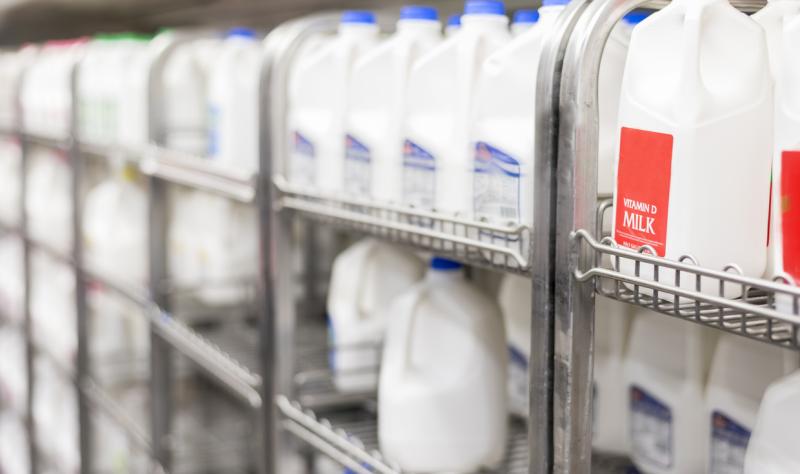
1 in 5 US retail milk samples test positive for H5N1 avian flu fragments
pauldingbabe
The Great Cat
Well damn! If it's that prolific we should be able to handle it. Right?
I mean 1 in 5 milk samples? Seriously, if this bug is that saturated in our food chain then everyone has been exposed and immunity should be taking hold.
I mean 1 in 5 milk samples? Seriously, if this bug is that saturated in our food chain then everyone has been exposed and immunity should be taking hold.
stop tyranny
Veteran Member
Maybe the title should read:
Lab engineered bird flu that infected Texas man successfully mutated to spread more easily, CDC reveals
desert_fox
Threadkiller
I am by one of the dairies that is affected here in Idaho. The other dairy's in the area have gone on total lockdown: every piece of equipment entering has to be washed and disinfected, essential personnel only. This includes milk transport trucks. The poor 4H kids who usually get their calf's from these places are SOL this year.
The initial outbreak came from cows that were recently shipped in the Texas but it has spread to two other dairy's in a two weeks time.
The initial outbreak came from cows that were recently shipped in the Texas but it has spread to two other dairy's in a two weeks time.
psychgirl
Has No Life - Lives on TB
I’m almost sure I’ve read you can’t catch it from eating the meat.
Or did I hallucinate that?
I fully understand the need for due diligence.The other dairy's in the area have gone on total lockdown: every piece of equipment entering has to be washed and disinfected, essential personnel only.
In my humble opinion they'll find songbirds or maybe even geese will be identified as the probable vector.
jward
passin' thru
Chris Turnbull
@EnemyInAState
Horrific outbreak of 'flu like illness' disease has killed a 19-year-old and seriously sickened many others in army outbreak as Covid continues to rampage and highly pathogenic bird flu takes off:
View: https://twitter.com/EnemyInAState/status/1785656823464284243
Chris Turnbull
@EnemyInAState
Outbreak happened on an Army barracks in Brazil: 77 are reported have symptoms, 24 hospitalised - a few one of them are so sick they are in ICU and one dead already:
View: https://twitter.com/EnemyInAState/status/1785657582511616131
@EnemyInAState
Horrific outbreak of 'flu like illness' disease has killed a 19-year-old and seriously sickened many others in army outbreak as Covid continues to rampage and highly pathogenic bird flu takes off:
View: https://twitter.com/EnemyInAState/status/1785656823464284243
Chris Turnbull
@EnemyInAState
Outbreak happened on an Army barracks in Brazil: 77 are reported have symptoms, 24 hospitalised - a few one of them are so sick they are in ICU and one dead already:
View: https://twitter.com/EnemyInAState/status/1785657582511616131
| lots more at his twitter thread. . .hmm. |

